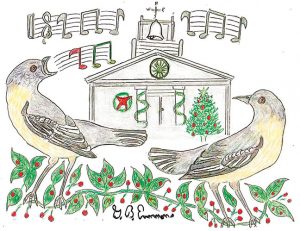The Northern mockingbird, formerly a southern bird, has now gradually increased its habitat northward to become a common year-round phenomenon to most of New England, with only a minor migration south for winter to be enjoyed as one of the true singers of our natural world.
It is classified in Latin as Mimus polyglottos, meaning “many-tongued mimic,” well-renowned for a vast vocabulary of up to 200 or more bird songs. Each tune is usually repeated from three to six times during the day, as well as at night during the mating season. It is believed that as the male expands his play list of songs, he becomes more attractive to females looking for a mate. Perhaps like the crooning of Bing Crosby and Frank Sinatra, its soothing moonlight performance might tend to provoke a prospective female’s romantic reproductive inclination.
Most people do not know that a mockingbird has also greatly adapted a similarly wide range of inanimate objects from man-made sounds around human beings. It can imitate loud laughter, the ring of an alarm clock, telephone ringtone, or doorbell, causing exasperation to anyone induced into trying to answer in response to one of these many false household alarms.
Outdoors it can mimic a train whistle or a siren from a firehouse. As in my illustration, it can also pick up a holiday tune being rung from the bell tower of a church. Perhaps seasonal Christmas carols such as Silver Bells or The Bells of St Mary’s would be appropriate. We may never understand completely which sounds this bird selects to emulate or why, but two physical features of its ability to vocalize are worthy of explanation.
The first clue may be in the composition and character of the song itself that can be easily adapted to the mockingbird’s capacity of mimicry. As opposed to mammals where sound-producing membranes situated down in the throat near the lungs, the mockingbird has seven pairs of membrane muscles higher up in the syrinx where a vocal pitch surfaces and is sent through the tube of the windpipe acting like the horn of a trumpet. Thus, what enters the ear is perceived loud and clear from the surface voice box that resonates the true quality of sound.
Before the Migratory Bird Treaty of 1918, young mockingbirds were taken from the nest and sold for domestication like parrots or parakeets, endangering their dwindling population in the south. But the quality of their songs did not come close to those raised in the wild.
Charles Darwin remarked on how the mockingbird developed such a remarkably broad vocabulary in its own evolution of species. Native American Choctaws called it hushi balbaha, “the bird that speaks a foreign tongue.” This ability has inspired countless popular songs, lullabies, paintings, poems, and literature. One of the most recognizable is the song and title of this article “Listen to the Mocking Bird,” its tune conceived in 1855 by African-American street musician Richard Millburn and written by Alice Hawthorn, which reportedly sold 20 million copies in sheet music and has been adapted into many forms throughout history ever since. It is a romantic verse about a young man dreaming of a mockingbird singing over the grave of his lost lover.
I will leave you now with the musical image of this mockingbird, whose song is intertwined with the sentimental life of mankind. It is his song about mortal life, love, family, and friends, orchestrated in tune with all the blessings of the natural world that might appropriately be brought to mind during this season of our holiday celebration.
By George B. Emmons
